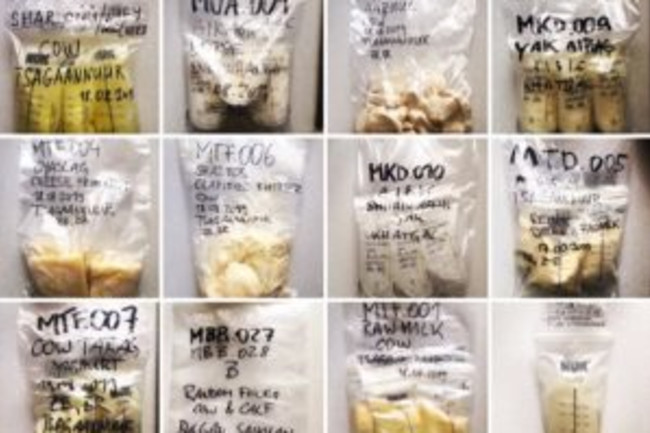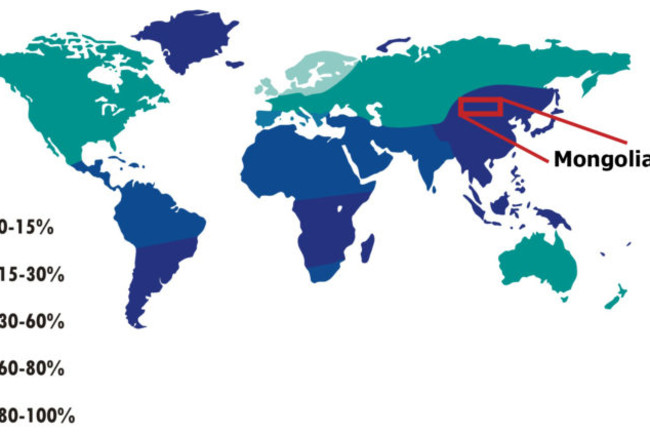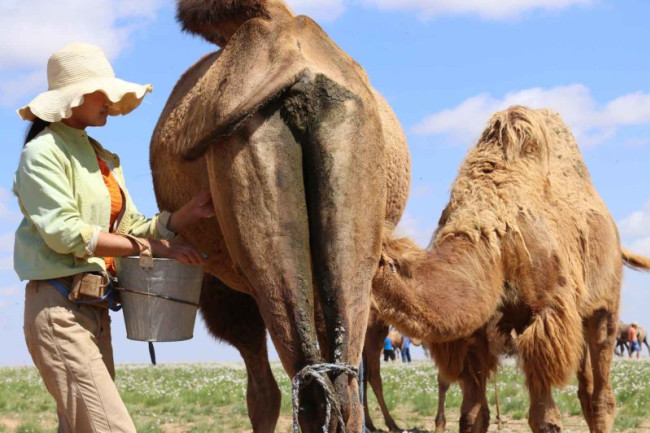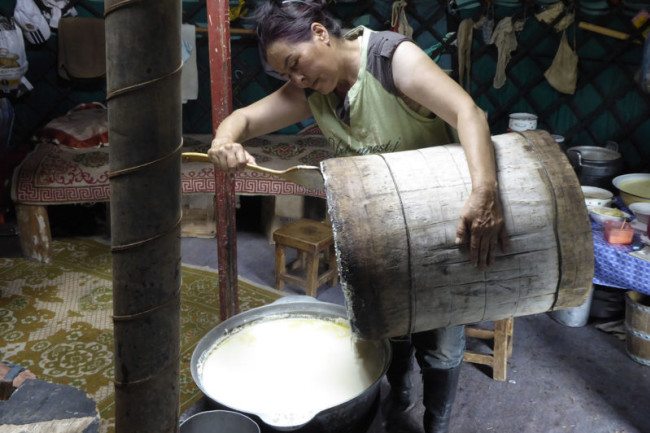In spring, as livestock calve and produce the most milk, Mongolians switch from a meat-centered diet to one based on dairy products. Each year, Dalaimyagmar thaws the saved sample of the previous season’s yogurt, which she calls khöröngo. She adds some of this yogurt to fresh milk, over several days, until it is revived. With this “starter culture,” she is then able to make dairy products all summer.
Afterward, as the anthropologists drove their struggling vehicle up steep hills back to their camp, graduate student and translator Björn Reichardt had a realization. Khöröngo is also the Mongolian word for wealth or inheritance.
In Mongolia, dairy products are vital dietary staples—more than 70 are made and consumed. From a certain perspective, then, the double meaning of khöröngo was unsurprising.
But there was some irony at work. In Mongolia, most herders have no idea that the khöröngo is, in fact, made up of a wealth of microbes. And that lack of knowledge could be a problem. Not only do these microbes bring benefits to the health, diet, and food practices of Mongolians—as well as a distinctive taste endemic to their cuisine—but they could be lost as Western industrial practices come to the country.
The Heirloom Microbes project has sampled a range of Mongolian dairy products, several of which are shown here. (Heirloom Microbes Project.)
It’s become a dual mission of Warinner’s to not only help Mongolians value their microbial riches, but also explore the impact these regional microbes have had on human history. “Bacteria are amazing, overlooked, and misunderstood,” says Warinner, who splits her time between the Max Planck Institute for the Science of Human History in Jena, Germany, and Harvard University in Cambridge, Massachusetts.
Warinner and her collaborator, Jessica Hendy, an archaeological scientist at the University of York, started the Heirloom Microbes project in 2017 to identify and preserve rare microbes, specifically the bacteria that turn lactose into lactic acid, the first step in transforming milk into yogurts and cheeses. In the process, they hope to understand which microbes were unique to specific early dairy communities—and how they spread from one region to the next.
Combining interests in ancient diets, traditional cultural practices, and gut microbiomes, the Heirloom Microbes project collaborators are blazing a trail that traces the origins of dairying—and promises to reveal previously unknown microbial influences on human culture. The project has sampled dairy products from several parts of the world, including the European Alps and Jordan.
Endangered Microbes
But the project team has focused on Mongolia, a country where traditional dairying practices from nomadic herding communities remained largely intact. Along the way, they have realized they may be sampling what are effectively endangered microbes if the world’s remaining traditional dairying societies industrialize.
Warinner, who calls herself a molecular archaeologist, set out to investigate past human diets more than 10 years ago. She found a goldmine of information trapped in the tartar on skeletal teeth, including the individual’s DNA, the oral bacteria they carried, and clues to that person’s eating habits.
That’s why Warinner teaches her archaeology students to wield an unusual tool: a dental scalar. Researchers use this hooked metal instrument, commonly found at dentists’ offices, to scrape ancient tartar from exhumed remains. The calcified microbial biofilm on teeth effectively offers researchers dietary sedimentary layers for each individual that can be preserved for centuries.
When the decayed plaque is particularly tough to dislodge, Warinner pops the ligament-free tooth out, cleans it, and puts it back—without damaging the skeleton itself. (Following training, her students receive a “Dental Hygienist to the Dead” certificate.)
Warinner first started scraping the hardened calculus from medieval skeletons in England, Germany, and Greenland to study ancient periodontal disease. Results from Greenland, however, yielded truly unbelievable results: milk proteins on teeth from Vikings who lived roughly 1,000 years ago. Convinced it must be a mistake, Warinner ignored the Greenland data for a year.
When she eventually re-ran the samples and got the same exact results, Warinner was flummoxed. “When I realized it might be real, I almost scared myself,” she says. “What if we could reconstruct dairying in the past?” Dairy, she realized, could serve as a window into human diets—and the practices supporting those diets—through time.
Milk proteins trapped in layers of tartar would allow Warinner to not only determine which animal produced the milk, but also date milk consumption across space and time, something that had previously only been attempted by tracing milk fats in ancient pottery. This new approach provided scientists with a way to “extract evidence of milk directly from the mouths of past people,” Hendy notes.
Milk and the microbes behind dairy products are intriguing objects of study on many levels, say Hendy and Warinner. For one, Hendy says, “Humans are the only species to drink another mammal’s milk.”
Even more intriguing is why early societies would practice dairying for thousands of years when they could not easily digest lactose, the sugar in milk. For decades, scholars thought that dairying increased after humans evolved a gene to digest milk.
The majority of the world is lactose intolerant (map percentages indicate the overall rate of lactose intolerance in each region). (NmiPortal/Wikimedia Commons)
But that presumption was overturned once the extent of lactose intolerance was documented. In fact, research suggests that dairying was practiced for 4,000 years before the emergence of a mutation that allowed lactose digestion.
Lactose Intolerance
Even today, the majority of people around the planet—65 percent—are lactose intolerant, meaning their bodies struggle to break down the sugar lactose found in fresh milk. (Mongolia offers a stark example: Consumption of dairy products in Mongolia remains extraordinarily high, despite the fact that 95 percent of Mongolians are lactose intolerant.)
Milk continues to be an incredibly fraught food, a lightning rod for discussions around nutrition and health. “It’s either a superfood or the worst thing in the world,” Warinner says.
“Dairying is this amazing invention that people came up with in prehistory,” she adds, “but it’s a complete puzzle why and how it worked.” In addition, dairy products were among the earliest manufactured foods.
And that is the work of microbes. “Cheese doesn’t exist in the wild,” Warinner says. Milk itself is highly perishable and goes bad in hours.
Through trial and error, humans figured out how to harness bacteria to consume the lactose—and thereby acidify and ferment milk into cheeses and yogurt, respectively.
“People from deep prehistory, millennia ago, were domesticating microbes they didn’t even know existed,” Warinner says. “It must have seemed magical to them.”
In fact, Warinner notes, this microbe-driven approach was likely among the earliest—and most important—food storage mechanisms in ancient times. Warinner and Hendy soon turned their interest to identifying early dairy microbes. If they could find milk proteins in skeletal tartar, they hoped to find DNA from the lactic acid bacteria.
In arid or grassland steppe regions like Mongolia, there would have been few shelf-stable foods several millennia ago. Dairying proved transformative. Given the harsh and arid environment, barren landscape, and limited foodstuffs, it is hard to imagine how Genghis Khan could have conquered Asia and Eastern Europe without portable, probiotic-rich, high-calorie cheese, explains Warinner.
Mongolians milk all seven livestock species in the country: cows, sheep, goats, horses, yaks, reindeer, and—as shown here—camel. (Heirloom Microbes Project.)
And the menu of dairy options is vast. Mongolians milk every one of the seven livestock species in the country: cows, sheep, goats, horses, yaks, reindeer, and camel.
From that native diversity, Mongolian milk products have a distinctive terroir, or characteristic flavor infused by the environment producing the food. Aaruul, which are dried, hardened curds eaten as a snack, have a pungent, tangy flavor. Shimiin arkhi is yogurt made from yak’s or cow’s milk that is distilled to make a vodka. Airag is a fermented mare’s milk liquor that is light and bubbly. “People listen to mare’s milk ferment and say, ‘It’s alive’ when they hear it fizzing,” Hendy says.
Mongolians hand down starter bacterial cultures, the khöröngo, from generation to generation—and typically the work is carried out by women. “They often receive starter cultures from their mothers, who received it from their grandmothers,” Reichardt says. “There is a chance that these microbes are hundreds of years old and still alive today.”
But when Warinner and Hendy first asked to collect dairy microbes in Mongolia, the nomadic herders denied their products had any bacteria in them. “In Mongolia, microbiology is taught from a clinical perspective—namely, that bacteria only cause disease,” Warinner says.
She found that herders were unaware of beneficial or food microbes. They also did not know that the hides and wooden vessels used to store starter cultures were crucial to maintaining these bacterial populations over time. Unbeknownst to contemporary and early herders, the porous, organic materials used as containers were inadvertently inoculated with the lactic acid bacteria over and over again. As a result, the containers themselves helped desirable microbial populations persist over time—in part because nothing else, including pathogens, could grow in the containers.
In Khövsgöl, Mongolia, herder Gerel scrapes curds from the inside of her century-old still after making shimiin arkhi, a vodka from distilled cow or yak yogurt. (Heirloom Microbes Project.)
“Pathogens are like weeds, they are the first to grow, whereas lactic acid bacteria are like old-growth trees,” Warinner explains. “If you get the lactic acid bacteria established, they’ll prevent weeds from growing.” In short, the traditional nomadic dairy model promotes the growth of “good” bacteria that naturally outcompete pathogens.
Western Ways
Still, that hasn’t stopped the spread of western practices, including industrialized dairy cultures. The Heirloom Microbes project has not found traditional practices to be as prevalent in the other regions the team has studied, such as Jordan and the European Alps, as compared to Mongolia. The concern, as stated in their project grant, is that with “contemporary food globalization and industrialization, traditional methods of dairying and their unique microbial cultures are being lost at an alarming pace.”
While traditional practices continue in isolated pockets in Jordan and the Alps, those practices can be, in part, a tourist attraction. European countries largely industrialized their dairying procedures in the 1970s and 1980s. In contrast with traditional methods using heirloom bacterial cultures, industrial practices begin with sterilization and then introduce lab-grown, high-performing bacterial cultures. In these industrialized systems, everything has to be constantly killed in large part because the first things to come back are pathogens.
For Warinner and her colleagues, helping Mongolian herders and policymakers understand the benefits of the traditional methods has become even more urgent as the first steps toward dairy industrialization begin in Mongolia. Most notably, European lab-grown starter cultures are being introduced into the region.
“Bacteria are amazing, overlooked, and misunderstood,” says anthropologist Christina Warinner.
Warinner does not think the lab-grown strains, produced under highly controlled conditions, will fare well in Mongolia simply because they lack the region’s traditional diversity. “These are cultures developed in a completely different environment,” she says. “Industrial methods of sanitation are not easily implemented on the steppe and doing so would disrupt the microbial ecologies that support traditional Mongolian dairying,” she notes. “I fear that well-intentioned attempts to introduce such techniques—without consideration of their cultural context—would actually reduce the safety of the dairy products and radically transform and undermine the lives of nomadic herders.”
Hendy adds that microbes may not only support the process of dairying but also play a role in people’s health and digestion. Microbes in traditionally made dairy foods help maintain a healthy gut microbiome, which could be altered—to unknown effect—by a switch to industrialized microbial cultures.
Over the past three years, the Heirloom Microbes project team has scraped tartar from roughly 200 skeletal remains around the world. As they piece together ancient microbial sequences in the tartar, they will start this summer to sample the microbiomes of both Mongolian nomadic herders and urban dwellers to determine whether herders’ gut microbes have played an unrecognized role in their dairy digestion.
As a growing body of research makes clear, the gut microbiome exerts a shocking degree of control over many aspects of our health—from mood to immune function to pain. It may even shape seemingly unrelated aspects of our behavior, including social interactions.
Mongolian researcher Soninkhishig Tsolmon has documented nutrition in her homeland for the last 20 years. It has not been easy. With few resources or existing studies available, Tsolmon has focused on the dietary differences between nomadic and urban people.
Science and Tradition
Tsolmon suspects that many traditional foods could reveal intriguing health and microbial connections—but time is running out. In addition to looming industrialization, climate change is transforming the landscape under herders’ feet.
“We’re starting to lose traditions,” Tsolmon says. “Mongolians have traditional ways of using meat and milk.” The traditional meat-based diet in the winter is replaced with fermented dairy products in the summer that, elders say, eliminate the toxins from a winter’s worth of meat eating. She adds, “I’m afraid that some bacteria are disappearing.”
To help stem the loss, Tsolmon, Warinner, and their colleagues created opportunities to share knowledge between the scientists and the herders. In July, for example, the researchers held a Seeing Microbes workshop in villages near Mongolia’s Lake Khuvsgul.
There the group showed local herders microscopic images of the bacteria in their dairy products. “We explained how their practices maintain plenty of good microbes in their products—and that microbes don’t just cause disease,” explains translator and graduate student Zoljargal Enkh-Amgalan. “They were proud of their way of life and how pastoralism and dairying still exist,” she adds.
At another meeting earlier last summer, traditional steppe herders, cheesemakers from the Swiss Alps, the Heirloom Microbes team, businesspeople, and government officials came together for a traveling conference held in both Mongolia and Kyrgyzstan. The German Federal Ministry of Education and Research and the European Research Council funded the meetings.
These disparate groups shared their insights on traditional practices and the science underpinning their success. While traditional dairying practices, which go back at least 5,000 years, have not been studied intensively, they are clearly adapted to the Mongolian landscape and sustainable, explains Warinner.
Warinner believes the deep time emphasis that her discipline brings to such discussions is especially valuable. “Anthropology matters. Archaeology matters,” she says. “We work to understand humans in the past and how we are today—in order to inform public opinion and government policies.” That perspective can help counterbalance the ways in which globalization and well-intentioned interventions may, intentionally or not, threaten traditions, with complex consequences.
In addition to educating Mongolians about the science underpinning their ancestral practices, Warinner and colleagues hope they will take stock of the microbes that have played a starring, yet unsung, role in their nutrition and health. It is ironic that Mongolia has this very deep tradition of dairying that is so central to identity, culture, and history—and yet possesses no archive or any centralized collection of the many bacterial cultures. The Heirloom Microbes project collaborators hope to develop and maintain a storehouse of these resources for Mongolia.
“We live in a microbial world,” Warinner says. “We are only now realizing how integral microbes are to being human.” Put another way, science is just starting to uncover the degree to which microbial cultures have shaped human cultures.
This work first appeared on SAPIENS. Read the original here.















